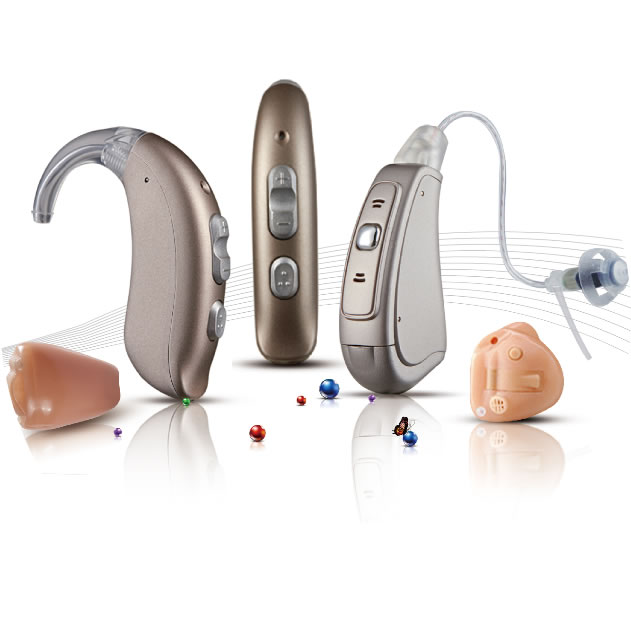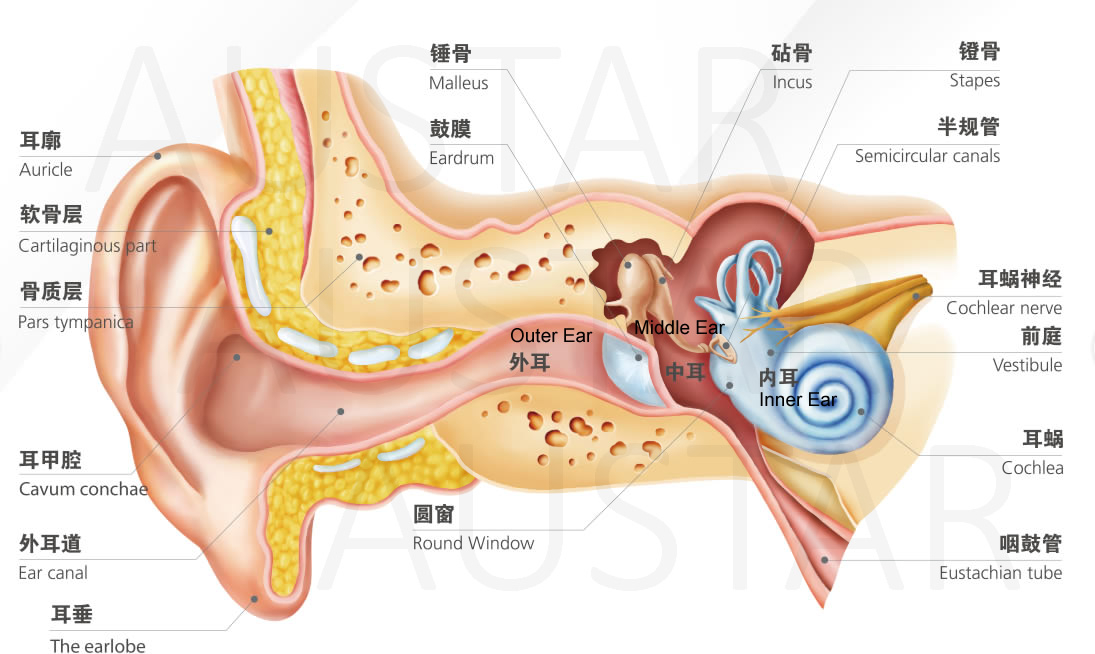Our hearing is very precious. If hearing loss is not treated, it will have a serious impact on people's ability to communicate, learn and earn a living. It also affects people’s mental health and ability to maintain relationships.
Types of hearing loss, tinnitus, how to solve hearing problems? Is your daily life affected by hearing loss and hearing problems? Learn how to improve your hearing, today.
Find facts about hearing health and hearing loss, how to avoid it if still possible, and help you figure out whether you or a loved one might already be showing symptoms without noticing. If you may already have lost some hearing, we offer reliable hearing solutions that can help restore life’s beautiful sounds.
How do we hear sound?
Here is a quick overview of how our ears work:
Outer Ear
Known as the pinna or auricle, this visible portion of the ear gathers sounds from the surrounding environment and sends it down the ear canal. The external auditory canal is not a straight channel, but a curved "S" shape, composed of cartilage and bone.
Middle Ear
The vibration of the tympanic membrane (eardrum) transmits sound to the inner ear through three small bones (malleus, incus and stapes) that carry sound to the inner ear.
Inner Ear
Made up of two main parts: the cochlea, a system of complex hair cells (sensory cells) and the vestibular system that sends sound to the brain for final processing.
Types of Hearing Loss
Noise-Induced hearing loss
This type of hearing loss can affect anyone at any age. Noise-induced hearing loss (NIHL) is caused by exposure to loud sounds that damages or destroys the hair cells in your inner ear. NIHL can result from a single exposure to an extremely loud impulse sound (e.g., a shotgun blast close to your unprotected ears) or regular exposure over time to sounds exceeding 85 decibels (dB). Examples of how NIHL may occur over time include listening to music turned up to maximum volume through earbuds or working with construction machinery without wearing hearing protection.
Sensorineural hearing loss
This type of hearing loss involves deterioration of the inner ear. The tiny hairs that line the ear passage and which carry sound have been damaged. This type of hearing loss is most commonly caused by prolonged exposure to high volume levels, bacterial and viral infections, fluid build-up, sudden trauma to the ear, and the normal aging process. Sensorineural hearing loss cannot be treated with medication or surgery — hearing aids are the only way to treat this permanent condition.
Conductive hearing loss
This type of hearing loss occurs when the inner ear does not properly receive sound signals. It can be caused by injury to the middle ear or ear canal, fluid build-up behind the eardrum, or excessive earwax. Conductive hearing loss can usually be treated medically. If surgery or medication is not an option for you, hearing aids can be an excellent solution to your hearing problem.
Sudden hearing loss
Hearing loss usually comes on gradually due to age (presbycusis) or NIHL taking their toll. However, certain conditions can cause sudden hearing loss, including exposure to an extremely loud sound that causes immediate damage, certain diseases, tumor, head injury, or use of ototoxic ("ear poisoning") drugs. In most cases, hearing will return over time, either on its own or through medical intervention, but for some the hearing loss may be permanent.
Signs of Hearing Loss
Signs of hearing loss can take years to develop or they may show up very suddenly. Either way, they can make everyday life more difficult. If you answer yes to any of the questions below, you could be exhibiting hearing loss symptoms.Contact a hearing health professional in your area for more information.
Hearing loss is not only a decline in hearing, but also affects the reduction of speech recognition rate and pronunciation function. Therefore, the degree and nature of hearing loss and the length of hearing loss have a crucial influence on the effect of hearing aid fitting. Because hearing loss is divided into three types: conductive, sensorineural, and mixed, the degree of hearing loss is divided into five categories: normal, mild, moderate, severe, and extremely severe. Conductive hearing loss is generally caused by the appearance of lesions in the outer and middle ear. This type of hearing loss only needs to amplify enough volume to achieve a more ideal hearing aid effect. Sensorineural and mixed hearing loss will cause a decline in speech recognition rate, a decline in discomfort threshold, and a recovery phenomenon. The more severe the hearing loss, the longer the time, and the more serious the recovery phenomenon, the worse the effect of fitting hearing aids will be.
Do you:
- Require frequent repetition of words?
- Have difficulty following conversations involving more than two people?
- Think others sound muffled or like they’re mumbling?
- Have difficulty hearing in noisy situations, like conferences, restaurants, malls, or crowded meeting rooms?
- Hearing on the phone is difficult
- Have the TV or radio turned up to a high volume?
- Answer or respond inappropriately in conversations?
- Have ringing in the ears?
- Read lips or more intently watch people’s faces when they speak?
- Feel stressed from straining to hear what others are saying?
- Feel annoyed at other people because you cannot hear or understand them?
- Withdraw from social situations that you once enjoyed because of difficulty hearing?
- Have a family history of hearing loss?
- Take medications that can harm hearing?
- Have diabetes, heart, circulation, or thyroid problems?
- Recall exposure to very loud sounds over a long period or a single exposure to explosive noise?
If you have hearing loss in both ears, it is recommended that both ears be fitted with otc hearing aids at the same time. Otherwise, it will be easier to cause the hearing on the side not wearing the hearing aid to receive sound stimulation and continue to decline, and the hearing on the side that is fitted with the hearing aid will continue to decline due to excessive fatigue. For hearing impaired patients, the sound of single ear fitting is unbalanced and has no three-dimensional effect, and the hearing cannot be effectively protected. Therefore, hearing patients should be fitted with hearing aids as soon as possible to delay hearing loss and delay speech comprehension.
How do hearing aids work?
A hearing aid basically consists of one or two microphones, an amplifier and a loudspeaker, also called receiver.
The microphone picks up the incoming sound waves and changes them into electrical signals. These signals are individually processed based upon the hearing loss and fitting parameters provided by the hearing care professional.
Complex algorithms in the hearing aids reduce harsh effects of loud sounds and also reduce background noise hindering speech perception. They are also able to enhance the fine nuances of music. All processed sounds are then converted back into electrical signals to deliver lifelike sound through the ear canal.
The necessary power needed by the hearing aid components are provided by batteries or rechargeable solutions.
Modern hearing aids feature also wireless systems to synchronize and optimize the processing of a left and right instrument and to establish a reliable, direct connection to external devices like TVs and smartphones.
OTC hearing aid types and costs
Types of OTC hearing aids: behind-the-ear (BTE) and in-the-ear (ITE) hearing aids. There are different styles, such as receiver-in-canal (RIC), in-the-canal (ITC), completely-in-the-canal (CIC), invisible-in-canal (IIC) and rechargeable hearing aids. Some hearing aids with open and instant-fit styles.
Hearing aid cost: We are a hearing aid manufacturer, we provide the most competitive price in the market, saving cost.


